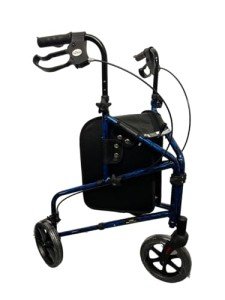
As the population ages, the need for mobility aids continues to grow. One of the most popular options for those seeking increased self-reliance and safety while browsing their environments is the sturdy rollator. These mobility aids offer necessary assistance, enabling users to walk with greater confidence and stability. In this post, we will explore what a sturdy rollator is, its benefits, functions to consider, ideas for usage, and responses to some often asked questions concerning rollators.
A sturdy rollator is a wheeled walker equipped with a frame, handlebars, and a minimum of three wheels, allowing users to preserve balance and support while ambulating. Unlike traditional walkers, which require lifting, rollators allow users to press and guide them forward without unneeded stress. Many rollators also consist of additional features, such as a seat for resting, a storage compartment, and brakes to guarantee safety.
A sturdy rollator uses a number of advantages for individuals with mobility difficulties. A few of the essential benefits include:
When selecting a sturdy rollator, numerous key features must be considered to ensure it fulfills individual needs. Here is a list of essential features to look for:
Below is a table showcasing some popular rollator models offered on the market, highlighting their essential features.
| Model Name | Weight Capacity | Wheel Size | Seat Height | Foldable | Additional Features |
|---|---|---|---|---|---|
| Drive Medical Nitro | 300 pounds | 10 inches | 21.5 inches | Yes | Lightweight, large storage basket |
| Medline Premium | 350 lbs | 8 inches | 20 inches | Yes | Cushioned seat, adjustable backrest |
| Hugo Elite Rollator | 300 lbs | 8 inches | 24 inches | Yes | Cup holder, detachable storage bag |
| Nova Vibe | 300 lbs | 8 inches | 21 inches | Yes | Stylish design, easy to navigate |
| Drive Lightweight | 300 lbs | 8 inches | 22 inches | Yes | Ultra-lightweight, adjustable deals with |
To guarantee a safe and reliable experience while using a rollator, consider the following ideas and best practices:
A rollator may be suitable if you require support for walking, have balance issues, or experience tiredness while standing. It's best to seek advice from a health care expert to evaluate your specific requirements.
Yes, many rollators are created for both indoor and outdoor use. Try to find designs with larger wheels and sturdy frames for outdoor surface.
Frequently check the brakes, tighten loose screws, and tidy the wheels and frame. Following the producer's standards for upkeep will help make sure longevity.
Yes! While rollators mostly assist with mobility, they can also be used for mild exercises, such as walking practice, leg raises, and balance exercises. Seek advice from a physiotherapist for tailored exercises.

Yes, alternatives include standard walkers, canes, and mobility scooters. The very best choice depends on individual requirements, preferences, and mobility levels.
For many people, a sturdy rollator can considerably enhance mobility, provide a sense of self-reliance, and facilitate an active lifestyle. By comprehending the benefits, features, and appropriate usage of rollators, users can make educated choices and improve their lifestyle. With the right rollator and appropriate usage, people can browse their environments confidently and securely.
No Data Found!

